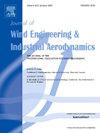方形圆柱体压力传感器布置的智能优化及风荷载时间序列预测
IF 4.9
2区 工程技术
Q1 ENGINEERING, CIVIL
Journal of Wind Engineering and Industrial Aerodynamics
Pub Date : 2025-08-23
DOI:10.1016/j.jweia.2025.106212
引用次数: 0
摘要
本文提出了一种结合固有正交分解(POD)和k -means++聚类分析的结构表面关键压力传感器分类和布置方法。对于从方形圆柱体上的多个压力传感器获得的风洞实验时间序列数据,POD-K-means++将传感器快速分组并生成轮廓分数。利用不同入射时的轮廓分数分布,提出了考虑不同传感器数量和轴对称条件下关键传感器的布置方案。采用POD-BPNN(反向传播神经网络)方法,利用有限传感器的数据预测任意周向位置的压力时间序列。通过比较10种不同轴对称传感器布局和20个相同传感器数量的POD-BPNN的总体预测精度,证明使用pod - k - memeans ++识别的传感器布局在所有情况下都具有优越的预测精度。进一步利用POD-BPNN研究预测误差对训练传感器数量(4-28,总传感器数量为44)的敏感性。20个训练传感器实现精度和效率之间的最佳平衡。本文章由计算机程序翻译,如有差异,请以英文原文为准。
Intelligent optimization of pressure sensor arrangement and prediction of wind loading time series on a square cylinder
This paper proposes a novel methodology for classifying and arranging key pressure sensors on structural surfaces by integrating Proper Orthogonal Decomposition (POD) and K-means++ cluster analysis. For the wind tunnel experimental time series data obtained from multiple pressure sensors on a square cylinder, POD-K-means++ quickly groups the sensors into several clusters and produces the silhouette scores. Using the silhouette score distributions at various incidences, the arrangement scheme of key sensors is proposed, considering various sensor amounts and an axisymmetric condition. The POD-BPNN (Back Propagation Neural Network) method is used to predict the pressure time series on any circumferential location using data from limited sensors. By comparing the overall prediction precision of POD-BPNN using 10 different axisymmetric sensor layouts and the same sensor amount of 20, the case using the sensor layout identified by POD-K-means++ is proven to have superior precision in all incidences. POD-BPNN is further used to study the sensitivity of prediction errors to training sensor amounts (4–28 within a total sensor amount of 44). 20 training sensors achieve an optimal balance between accuracy and efficiency.
求助全文
通过发布文献求助,成功后即可免费获取论文全文。
去求助
来源期刊
CiteScore
8.90
自引率
22.90%
发文量
306
审稿时长
4.4 months
期刊介绍:
The objective of the journal is to provide a means for the publication and interchange of information, on an international basis, on all those aspects of wind engineering that are included in the activities of the International Association for Wind Engineering http://www.iawe.org/. These are: social and economic impact of wind effects; wind characteristics and structure, local wind environments, wind loads and structural response, diffusion, pollutant dispersion and matter transport, wind effects on building heat loss and ventilation, wind effects on transport systems, aerodynamic aspects of wind energy generation, and codification of wind effects.
Papers on these subjects describing full-scale measurements, wind-tunnel simulation studies, computational or theoretical methods are published, as well as papers dealing with the development of techniques and apparatus for wind engineering experiments.

 求助内容:
求助内容: 应助结果提醒方式:
应助结果提醒方式:


